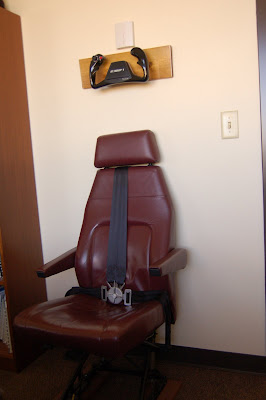
Kevin L. Bredenbeck is sitting in the catbird seat, literally.
As chief test pilot for the Sikorsky Aircraft's
X2 advancing blade concept (ABC) demonstrator, Bredenbeck is a member of the elite few pilots chosen to lead civil rotorcraft into the next dimension -- speed.
He’ll very soon be the first to fly the X2, taking off from Sikorsky’s “Hawk Works” rapid prototyping facility in Elmira, New York, hovering at first, then progressively pushing the 6,500lb craft to cruise speeds of 250kt or more, well in excess of a P-51 Mustang and 100kt faster than today’s civil helicopters.
Sikorsky experimented with the ABC concept with the
XH-59A in the 1970s, reaching speeds of 240kt. However, many of the technologies needed to handle the vibration, flight control and power transmission issues were not yet mature at the time.
Sikorsky president Jeff Pino, a former Army helicopter pilot, has big plans for X2 technology, saying it will no less than revolutionize the rotorcraft industry by offering traditional vertical lift capabilities but maximum cruise speed in the neighbourhood of 270kt with no configuration change, a la tilt rotor technologies.
The company envisions smaller versions that could perform as armed escorts for the V-22 Osprey and 19-seaters carrying oil industry workers to ever more distant drilling platforms.
The
X2 gets its speed through counter-rotating dual rigid main rotors that allow the retreating blade on each side to be largely unloaded, removing the drag barriers facing traditional rotorcraft. Counter-rotating main rotors also allow the X2 to have a velocity enhancing pusher propeller rather than the typical anti-torque rotor on the tail.
For Bredenbeck, 48, his front seat view came about by a little luck and much hard work and planning.
He began flying gliders at 15 in Waterbury, Connecticut while attening high school in Springfield, Massachusetts, accumulating 30 hrs. He eventually soloed in gliders during his college years, which he spent at the
Embry Riddle Aeronautical University in Daytona Beach, Florida, earning a B.S. degree in Aeronautics and Avionics.
In addition to earning fixed wing ratings during those years – private, instrument and commercial – he continued to fly gliders and to this day has accumulated 110 hrs in more than 250 flights.
The desire to fly was planted early on, when his father, a member of the US Air Force, took him to air shows. He also remembers being “glued to the TV” during the
NASA Apollo launches. “I knew I wanted to be an astronaut or test pilot.”
After college, Bredenbeck decided to truly put his dream into action in the military. Fate intervened however. “The day before I was to go in to sign the paperwork to join the military, an offer came from NASA,” he says.
That offer was from United Space Boosters, Inc., a subsidiary of United Technologies, also the parent company of Sikorsky. His newfound role was that of systems engineer in the Vehicle Assembly Building at the Kennedy Space Centre, specializing in solid rocket booster for the space shuttle, a job he kept for two years, from 1982 to 1984.
Next Bredenbeck transferred to Sikorsky, working “test issues and problems” for the helicopter manufacturer while continuing his general aviation flying on the side.
A challenge issued by Sikorsky test pilot John Dixon then set the stage for Bredenbeck to move forward. “What do you want to do with your career,” he recalls Dixon asking.
“I want to be a test pilot."
“Then go do it,” replied Dixon.
He did, joining the US Army to fly helicopters.
Bredenbeck went through flight training and earned the rank of 2nd Lt. He was assigned to fly Sikorsky UH-60 Black Hawks in the test division at Fort Rucker, Alabama. He later flew Medivac UH-60s in Korea and Germany.
After finishing his tour of duty with the Army, Bredenbeck became a full-time pilot for the Army National Guard, but later applied for a job at Sikorsky’s flight department, where John Dixon was now chief test pilot. “He remembered me,” says Bredenbeck.
Hired in May 1994, Bredenbeck went to work flying test pilot duties on a program to introduce four-axis coupled autopilots on UH-60s. He also tested the UH60Q medivac helicopter, was the UH60M project test pilot, and worked the fly-by-wire and automatic flight control system projects for Sikorsky, all of which led the way to his shot at the catbird seat.

Though the X-2 has tandem seating for two, the rear seat is loaded with test equipment for the first flight. In the front, Bredenbeck will control the X2 with a fly-by-wire side-arm controller on his right side, a leftover from the cancelled Comanche helicopter program, and a collective stick on this left. On the collective is a “beeper” control that he’ll use to increase power from the main rotor to the six-bladed propeller at the rear of the aircraft. Ideally, the X2 will deliver 90% of the 1,680shp LHTEC T800-801 turboshaft engine, also a gift from the Comanche program, to the pusher propeller during criuse.
Along with his duties as chief test pilot at Sikorsky, Bredenbeck is also director of test and evaluation, and as such, is responsible for the oversight of all test and flight activities at the company's facilities in Stratford, Connecticut and West Palm Beach, Florida.
Bredenbeck and wife Barbara, married 27 years, have two grown children.









